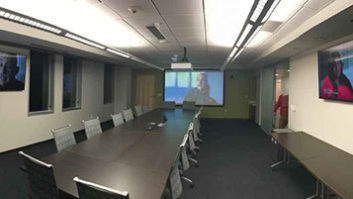Are you the parent of two or more children? Ask yourself this simple question: which is your favorite child? Of course, you’ll likely reply, “Well, I love all my children!” While that may be true, in reality there often tends to be one, typically the oldest, who is the most responsible (Julie, watch your little brother while I run to the store). A first, if you will, among equals.

David Young, president of The Sound Room, Chesterfield, MO
And so it is with most successful integration companies. Sure, everyone on the team matters; but the person most responsible for ensuring that a proposal becomes a living, breathing (and reliably operating) system, delivered on time and on or below budget to a fully satisfied client, is the project manager.
Our Panel of Expert Integrators
A selection of high-performing integration companies offered their perspective on the role of the project manager in the success of their operations. This group includes David Welles, president of TVTi in Chicago, IL; Avi Benaim, president of A.B.E. Networks in Silver Spring, MD; Mark Ormiston, president of Definitive in Bellevue, WA; and David Young, president of The Sound Room, Chesterfield, MO.

David Welles, president, TVTi
There are different business models that integrators use to address the issue of project management. Some, for example, have their salespeople both sell and manage their own projects. Others will have a lead technician take on the responsibility to manage the project.
And while there are successful examples of each of these different business models, in the case of our expert panel of integrators, they all recommend and utilize an independent project manager role within their organizational structures. However, in their early days, many on our panel have experimented with other structures.
Which Model is Best?
“We’ve had project managers for years, but before that, the salesmen would PM their jobs,” Young said. “The benefit of switching to separate project managers was that we wouldn’t have these peaks and valleys in the sale cycle. So the salesmen can sign a job and move on to the next job and sign that one–as opposed to sign a job and then do all the PM work, and in the meantime, not take any new opportunities.”
“In our earlier days, we would have a lead tech also be the project manager…and that doesn’t work,” Welles said. “Then we went to the sales guy managing his projects. We have three sales guys here, two of them used to do the ordering, the scheduling, and then project management of their project. Now…anybody who has any common sense knows, you have a sales guy to sell.”

Mark Ormiston, president of Definitive in Bellevue, WA
Over the years, Mark Ormiston has analyzed many different versions of organizational charts, noting that at Definitive, “Our model is the highest overhead model.” Ormiston said he knows some very successful companies utilizing either salespeople or lead techs as PMs. But, “I can’t get my head wrapped around that. When you’re project managing, you’re not active in business development or new revenue generation; you end up with a real roller coaster based on where they spend their time. I think that most people would look at that and say that the skills that are best suited for a high-performing salesperson are not aligned with the skill sets for a high- performing project manager.”
Still, Ormiston said it’s possible to make any system work: “I am of the opinion that it is not so important that one org chart is the best, or one process belief is the best–I think what’s important is the blocking and tackling. I think you choose a way of doing things and–as long as every day, without fail, one foot in front of the other–every day you just do it and do it. Choose your system and don’t vary from it.”
The Role of Project Manager
There was broad agreement among the panelists on just what the role of the project manager entails–and a warning that being a project manager isn’t for the faint of heart.
“Basically, their position is to manage the project from the pre-pre-wire stage all the way to final and delivery of the project,” Benaim said. “That means going to customer meetings, going to meetings with the builders, going to show the technical staff what needs to be done–and then following up on their work. Doing quality control on the project, and then finally delivering a tutorial…along with the salesman.”
Young looked at it from the perspective of what kind of jobs require a project manager: “We define a job that requires a project manager as any job that has a ‘-tron’ in it…whether it’s a Crestron or a Lutron, it’s a -tron job,” Young said. “Or any multi-phase job, you know, a pre-trim to final job. Or a job where we’re interfacing with other trades–builders, architects, electricians–any other kind of trades like that. So those jobs get assigned a project manager and we fund it with up to a 5 percent fee on the total project. Also, all commercial jobs require a PM.”
Borrowing from the world of sports, offered an analogy. “If we talk in terms of a baseball team: the salesman is really the general manager, the installers are the players, and the project manager is the coach.”
The role, Welles added, is really about coordination: “Making sure everything’s done right, checking the sites to make sure they’re ready for us–and any additional things that are needed, such as scheduling, are all communicated through the project manager.”
At Definitive, Ormiston has created an entire support ecosystem, designed to keep their project managers focused. The company has schedulers, buyers, and accounts receivable people to take those duties off the backs of their project managers.
“Our PMs are involved in estimation, we have them involved in vetting the proposal, and we have them involved in the field management and change-order process,” Ormiston said. “We don’t have them signing contracts or spending a lot of time on accounts receivables or payment schedules, and so on. We have dedicated project administration people that do the job costing and the financial tracking of the job.
“We also have a dashboard that allows the PM, the project administrators, field supervisors, and other managerial types here to be able to see the progress of these jobs. And the PMs, on a daily basis, are adding field notes [to the system] so that everyone can see where we’re at with a job,” Ormiston added.
What’s a Reasonable Workload?
Although there are minor differences in how each of these professionals defines the role in their organizations, they seemed to be in fairly close agreement on the issue of just how many projects one project manager can handle effectively at any one time.
“What I’ve seen typically as the maximum that a PM can handle in our organization at any given time is a contract value of around $2.5 million each; and maybe that would be at any given time that they’re actively managing between five and 20 projects,” Ormiston said. “Now, they’re not doing 20 $1-million projects; they’ll have a mix in those 20 projects. They’ll have one that’s a million dollars in total value…and they’ll have a couple that are maybe $25,000 in total value…so yeah, they can have as many as 20 that are on the books. Once it gets above 20, then you’re looking at adding a person.”
The PM workload situation at TVTi is in the same range: “We’re in the process of looking for another project manager, because I firmly believe that you can’t really manage more than five projects [simultaneously] well,” Welles said. “Each of them may have 10 total projects, but one or another may be three months down the road–you know what I mean?”

Avi Benaim, president, A.B.E. Networks
Down near Washington, DC, Benaim runs at a slightly higher rate. “Typically we try to limit them to 10. I sometimes can juggle up to 25 or 30, but I’m the owner of the company and I have a couple of junior guys that follow me around that will do a lot of the legwork.”
Like the others, Young has thought this topic through pretty carefully. “We look at not only jobs, but the dollar amount–and also at the fact that all of these jobs are at different phases. We figure that a PM can handle around 10 jobs before we need to look at bringing on another one. Those jobs are all at different phases, so you may have a PM job where there might be three or four months go by where there’s nothing that we need to do on it.
Workload is a worthwhile consideration that any integrator’s management should consider, as Ormiston warned about the hazards of overloading PMs.
“Not only will they become less effective, but it’s one of the highest burn-out positions that I’ve seen,” he said. “It’s a thankless job: they’re the pickle in the middle, or the hub of a spoked wheel. So they’re tasked with communicating with all the different participants in the project…the client, the salesperson, purchasing, warehouse, accounting, me… and so it’s coming at them from all directions.”
Characteristics and Required Skills
Welles was succinct about the traits he felt that a good PM is required to possess: “They have to be organized. They have to be able to multitask and deal with quick-to-react-to problems,” he said. “They have to be a great communicator and they need a great work ethic. That’s it–everything else they need, we can teach them.”
Young looks for a specific personality type. “They have to be a high “S” and a high “C” on the DISC personality assessment test: they have to score high in both steadiness and compliance [as shown on that test],” he said. “They have to also be very strict and organized…and yet they’re interfacing with other trades, so you’ve got to have a little personality too.”
Benaim adds that image is an important element as well. “I think that what they look like is very important: a professional-looking person showing up dressed in khakis or dressed in jeans that are not ripped, always wearing a shirt with the company name on it. Image is very important–you have to actually look like a person of authority.”
Definitive’s Ormiston, who considers project management a profession in its own right, described a personality type necessary for success: “You’ve got to have a thick skin, and you’ve got to be able to collaborate with a team,” he said. “They’re personable and they can work with manufacturers, and they can negotiate, and they can de-escalate things with clients. It’s a nuanced role, and that’s why it’s a highly compensated position within our industry’s wage scale.”
“And,” Ormiston added, “it is something that not everyone’s cut out for. They’ve got to love it, too. They’ve got to want to do it. They’ve got to have enough technical knowledge…and then you cross your fingers.”
Ted Green publishes a weekly CE business blog at Stata-gee.com, the online home of The Stratecon Group, his marketing and strategy agency for the tech industry.







